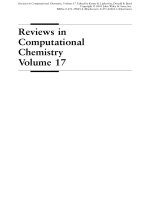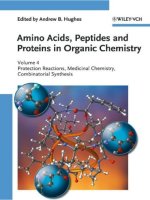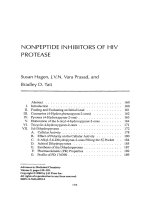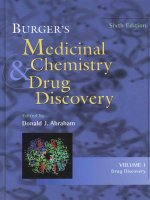Progress in medicinal chemistry volume 53
Bạn đang xem bản rút gọn của tài liệu. Xem và tải ngay bản đầy đủ của tài liệu tại đây (16.85 MB, 204 trang )
Elsevier
Radarweg 29, PO Box 211, 1000 AE Amsterdam, The Netherlands
The Boulevard, Langford Lane, Kidlington, Oxford, OX5 1GB, UK
32 Jamestown Road, London NW1 7BY, UK
225 Wyman Street, Waltham, MA 02451, USA
525 B Street, Suite 1800, San Diego, CA 92101-4495, USA
First edition 2014
Copyright © 2014, Elsevier B.V. All rights reserved
No part of this publication may be reproduced, stored in a retrieval system or transmitted in
any form or by any means electronic, mechanical, photocopying, recording or otherwise
without the prior written permission of the publisher
Permissions may be sought directly from Elsevier’s Science & Technology Rights Department
in Oxford, UK: phone (+44) (0) 1865 843830; fax (+44) (0) 1865 853333; email:
Alternatively you can submit your request online by visiting the
Elsevier web site at and selecting Obtaining permission
to use Elsevier material
Notice
No responsibility is assumed by the publisher for any injury and/or damage to persons or
property as a matter of products liability, negligence or otherwise, or from any use or
operation of any methods, products, instructions or ideas contained in the material herein.
Because of rapid advances in the medical sciences, in particular, independent verification of
diagnoses and drug dosages should be made
British Library Cataloguing in Publication Data
A catalogue record for this book is available from the British Library
Library of Congress Cataloging-in-Publication Data
A catalog record for this book is available from the Library of Congress
ISBN: 978-0-444-63380-4
ISSN: 0079-6468
For information on all Academic Press publications
visit our website at store.elsevier.com
Printed and bound in United Kingdom
14 15 16 12 11 10 9 8 7 6 5 4 3 2 1
PREFACE
This year’s volume of Progress in Medicinal Chemistry considers a new
approach to drug design in what has historically been the most important
class of receptor targets. In addition, we examine progress in the design
of ligands for three specific proteins providing potential therapies for
important disease classes. Our first chapter reviews an entirely new strategy
for finding agonists and antagonists of G-protein coupled receptors
(GPCRs) made possible by breakthroughs in the understanding of how their
structure and function are linked, and in the effective crystallisation of lipid
soluble proteins. Two chapters are concerned with ion channel targets in the
central nervous system (CNS), one modulating neurotransmitter release and
the other nerve signal conduction. They illustrate differing methods of
achieving target selectivity. A fourth chapter analyses recent work on a
protease long thought to be important in Alzheimer’s disease progression.
GPCRs are at the top of the list of historical successes in drug discovery.
Recent times have seen the field boosted by breakthroughs in understanding
of allosteric modulation and of the regulation of different intracellular
signalling processes, but possibly the most significant advance from the
medicinal chemistry viewpoint is the increasing availability of crystal structures of stabilised proteins. In Chapter 1, Congreve and colleagues review
the information obtained from such GPCR crystal structures which represent forms normally present only transiently in the fluxional native receptor.
Their emphasis is on the key interactions within the ligand binding sites, and
several examples are given of how this knowledge is starting to be exploited
for drug discovery, with crystal structures of key GPCR illustrated. Visualisation of the complex and divergent shapes and physicochemical features of
ligand binding sites enables computational and medicinal chemists to carry
out virtual screening, and to design optimised small-molecule agonists and
antagonists with improved potency, selectivity and ligand efficiency. The
authors also briefly outline complementary approaches to structure-based
drug discovery including fragment-based screening.
P2X7 is a member of the purinergic family of receptors. It is an adenosine
triphosphate (ATP)-gated ion channel thought to contribute to neuroinflammatory tone involved in neuropsychiatric and neurodegenerative
disorders as well as neuropathic pain. Chapter 2 reviews the work of many
teams of researchers and illustrates the challenge of designing drug-like
v
vi
Preface
ligands for a rather lipophilic binding site. This work has nevertheless
resulted in several distinctive clinical candidates, and the efficacy of these
potential drugs in clinical studies of CNS diseases is eagerly awaited.
Alzheimer’s disease is acknowledged to be one of the most important
challenges for health-care systems today, and this will increase as the average
age of the population rises. Much debate is focussed on the role of amyloid
peptides and their precursor proteins in the causation of the disease, and a
great deal of research effort has been expended in this direction. Secretases
are involved in regulation of the amyloid proteins, and Hall and colleagues in
Chapter 3 specifically review recent work on gamma secretase. A key
problem is finding drugs which modulate enzyme activity only in the
disease-causing pathway, and while several compounds have advanced into
clinical trials, there is as yet no sign of a successful drug emerging. Work
continues on achieving clinical efficacy with an adequate safety profile,
and the authors review differing approaches taken to address this challenge.
The importance of voltage-gated calcium channels (VGCCs) in basic
physiological processes such as cardiac and neurological function has
generated intense interest in these proteins as targets of pharmacological
intervention. N-type calcium channels are a subset of VGCCs distinguished
by their physiology, pharmacology and significance to the pathology of
chronic pain. While as a class calcium channel blockers have provided a
significant number of successful medicines for treating cardiovascular disorders, despite decades of investigation, only a single drug targeting the specific
N-type channel function has entered the marketplace, and one with severe
limitations on mode of delivery. Chapter 4 summarises current understanding of the biology, physiology and pharmacology of N-type calcium
channels and the implication of these features for therapeutic intervention.
From this basis of understanding, the authors describe recent efforts to
discover and develop peptide-based modulators of N-type calcium channel
function, and in particular small-molecule blockers with potential for oral
dosing.
GEOFF LAWTON
DAVID WITTY
October 2013
CONTRIBUTORS
Anindya Bhattacharya
Janssen Research and Development, LLC, San Diego, CA, USA
Christa C. Chrovian
Janssen Research and Development, LLC, San Diego, CA, USA
Miles Congreve
Heptares Therapeutics Ltd, BioPark, Welwyn Garden City, Hertfordshire, United Kingdom
Joa˜o M. Dias
Heptares Therapeutics Ltd, BioPark, Welwyn Garden City, Hertfordshire, United Kingdom
Adrian Hall
Department of Chemistry, Discovery Research, Neuroscience and General Medicine
Product Creation Unit, Eisai Ltd., EMEA Knowledge Centre, Mosquito Way, Hatfield,
United Kingdom
Margaret S. Lee
Research & Translational Medicine, Zalicus Inc., Cambridge MA, USA
Michael A. Letavic
Janssen Research and Development, LLC, San Diego, CA, USA
Fiona H. Marshall
Heptares Therapeutics Ltd, BioPark, Welwyn Garden City, Hertfordshire, United Kingdom
Toshal R. Patel
Department of BioPharmacology, Discovery Research, Neuroscience and General Medicine
Product Creation Unit, Eisai Ltd., EMEA Knowledge Centre, Mosquito Way, Hatfield,
United Kingdom
Jason C. Rech
Janssen Research and Development, LLC, San Diego, CA, USA
ix
CHAPTER ONE
Structure-Based Drug Design for
G Protein-Coupled Receptors
Miles Congreve, João M. Dias, Fiona H. Marshall
Heptares Therapeutics Ltd, BioPark, Welwyn Garden City, Hertfordshire, United Kingdom
Contents
1.
2.
3.
4.
5.
6.
7.
Introduction
Structural Architecture of GPCRs
GPCR Protein–Ligand X-Ray Structures
Mechanisms of Activation: Agonist Bound Structures
Biased Agonism
Traditional Approaches to GPCR Drug Discovery and the Need for Change
Potential of SBDD and FBDD for GPCR Drug Discovery
7.1 Beta Adrenergic Receptors
7.2 Histamine Receptor
7.3 Adenosine Receptors
7.4 CXCR4 Receptor
7.5 CRF1 Receptor
8. Conclusions and Outlook
Acknowledgments
References
1
3
31
35
39
40
41
42
45
46
52
53
54
55
55
Keywords: GPCR, Structure-based drug design, SBDD, Fragment-based drug design,
FBDD, Fragment, Antagonist, Agonist
1. INTRODUCTION
All cellular surfaces within the human body encompass membrane
spanning proteins, which sense the environment and trigger intercellular
communication by activating signal transduction pathways. G proteincoupled receptors (GPCRs) are the largest family of membrane-bound
receptors and they mediate responses to diverse natural ligands including
Progress in Medicinal Chemistry, Volume 53
ISSN 0079-6468
/>
#
2014 Elsevier B.V.
All rights reserved.
1
2
Miles Congreve et al.
hormones, neurotransmitters and metabolites, which can vary in structure
from simple ions, through small organic molecules to lipids, peptides and
proteins [1–3]. Binding of the ligand to the GPCR protein results in a conformational change. This leads to recruitment of intracellular signalling molecules including G proteins and b-arrestin [4,5]. GPCR activation can lead
to rapid cellular responses such as the activation of ion channels, slower
responses mediated by cascades of intracellular enzymes or long-term
changes in gene expression. Such events can result in various physiological
responses including contraction or relaxation of smooth muscle, synaptic
transmission in the nervous system, recruitment of immune cells to sites
of inflammation or long-term behavioural changes [6].
The prevalence of GPCRs combined with their pivotal role in cell sensing and signalling means that they are one of the richest sources of drug targets for the pharmaceutical industry. Drugs that mimic or block the activity
of the natural ligands of GPCRs are used to treat diseases of the central nervous system, such as schizophrenia and Parkinson’s disease, diseases of the
cardiovascular and respiratory system, such as hypertension and asthma, metabolic diseases including diabetes and obesity, as well as cancer and HIV
infection [7–9]. Currently, up to 30% of marketed drugs are directed at
GPCR targets [10,11]. Despite this success, a wealth of novel drug targets
remains as yet untapped. Fewer than 20% of the 390 non-olfactory GPCRs
have been drugged with small molecules and over 100 of these receptors
remain ‘orphans’ whose ligands and biology are as yet uncharacterised
[12]. In 2010 there were over 3000 GPCR-targeted drugs in clinical development, although the majority were aimed at the same targets as existing
drugs [13].
During the past 5 years there has been a revolution in the industry’s
approach to GPCR drug discovery, enabled by the ability to obtain purified
protein for biophysical and structural studies. The structures of more than
20 GPCRs have been solved in complex with peptides and small molecule
ligands and, in some cases, in both active and inactive conformations.
This provides an unprecedented wealth of information regarding the
molecular interactions of ligands with their receptors, allowing rational
structure-based drug design (SBDD) to be employed effectively with
GPCRs for the first time. Here we review the information obtained from
GPCR crystal structures with an emphasis on the key interactions within
the ligand binding sites and some examples of how this knowledge is starting
Structure-Based Drug Design for G Protein-Coupled Receptors
3
to be exploited for drug discovery. We also briefly outline complementary
approaches to structure-based drug discovery including fragment-based
screening. Finally, we discuss future challenges and opportunities in this rapidly moving field.
2. STRUCTURAL ARCHITECTURE OF GPCRs
GPCRs feature the common topology of seven membrane spanning a-helices (7TM) with an extracellular N-terminus and intracellular
C-terminus. Although all GPCRs are considered to be derived from a
common ancestral protein they have diverged into a large family with
over 800 members which can be classified into different sub-families
[14]. Over 400 of these are olfactory receptors involved in smell and
taste. The remaining receptors fall into five main families (Class A,
Secretin and Adhesion [together Class B], Class C and Frizzled). Class
A or rhodopsin is the largest family with approximately 300 members
and includes the aminergic (e.g. dopamine and histamine) receptors,
neuropeptide receptors, chemokine receptors, receptors for lipids and
eicosanoids and glycoprotein hormone receptors. Despite the great
diversity in ligand structure, the mechanisms involved in receptor activation are remarkably well conserved, with almost all drugs for Class A
receptors binding to the same region, whatever the nature of the natural
endogenous ligand [15].
Class B GPCRs comprise both the Secretin family (15 members) and the
Adhesion family (33 members). The Secretin family includes many targets
important in disease including the glucagon-like peptide receptor (GLP-1),
a target for diabetes, and the parathyroid hormone receptor (PTH1), a target
for bone diseases such as osteoporosis. This family has proved extremely
difficult to drug with small molecules, although many of the natural
peptide ligands serve as therapeutic agents [15,16]. Structures of the first
two representatives of Class B receptors, the glucagon receptor and the corticotropin releasing factor (CRF1) receptor have recently been solved
[17,18] (Table 1.1). The Adhesion family members are characterised by a
conserved transmembrane domain (TMD) linked to a very large extracellular domain, which comprises adhesion-like subdomains and a domain that
undergoes intracellular proteolytic cleavage (known as the GPCR
Table 1.1 List of Published GPCR Crystal Structures
Target GPCR and Description of Binding Pocket
Ligand Binding Site
b2 Adrenergic receptor complex with the inverse
agonist carazolol (1) at 2.4 A˚, PDB ¼ 2RH1 [19].
Carazolol makes key H-bond interactions with
Asp1133.32, Asn3127.39 and Tyr3167.43 from the
basic amine and with Ser2035.42 from the carbazole
NH.
The carbazole ring system is surrounded by
hydrophobic interactions within the vicinity of
residues Val1143.33, Phe1935.32, Tyr1995.38,
Ser2075.46, Phe2896.51, Phe2906.52, Asn2936.55 and
Tyr3087.35. Other residues in the binding pocket
comprise Trp1093.28, Val1173.36, Ser2075.46 and
Trp2866.48.
VII
VI
Asn293
Phe193
Asn312
Phe290
V
Ser203
Tyr316
Asp113
Ser207
II
III
IV
b2 Adrenergic receptor with the inverse agonist ICI
118,551 (2) at 2.84 A˚, PDB ¼ 3NY8 [20].
The inverse agonist ICI 118551 makes key H-bond
interactions with Asp1133.32, Asn3127.39 and
Tyr3167.43, and a p–p interaction with Phe2906.52.
Other residues in the binding pocket comprise
Trp1093.28, Val1143.33, Val1173.36, Thr1183.37,
Phe1935.32, Tyr1995.38, Ser2035.42, Ser2075.46,
Trp2866.48, Phe2896.51, Asn2936.55 and
Tyr3087.35.
VII
VI
Asn293
Phe193
Asn312
Phe290
V
Ser203
Tyr316
Asp113
Ser207
II
III
IV
Continued
Table 1.1 List of Published GPCR Crystal Structures—cont'd
Target GPCR and Description of Binding Pocket
Ligand Binding Site
b2 Adrenergic receptor-Gs protein complex with
the agonist BI-167107 (3), at 3.20 A˚, PDB ¼ 3SN6
[21].
The ligand BI-167107 makes key H-bond
interactions with Asp1133.32, Ser 2035.42,
Ser2075.46, Asn2937.20 and Asn3127.39 and a p–p
interaction with Phe2906.52. The H-bonding
interactions with the two Ser residues on TM5 is
typical for an agonist ligand and antagonists or
inverse agonists do not interact with either of these
residues. Overall the binding site is slightly smaller
around the agonist compared with antagonists (see
main text).
Other residues in the binding pocket comprise
Trp1093.28, Thr1103.29, Val1143.33, Val1173.36,
Thr1183.37, Asp192ECL2, Phe193ECL2, Tyr1995.38,
Ala2005.39, Ser2035.42, Ser2075.46, Trp2866.48,
Phe2896.51, Asn2936.55 and Tyr3087.35and
Ile3097.36. The residues Asp192ECL2 and
Phe193ECL2 are located in the ECL2 loop, capping
the ligand binding site. The side chain of these
residues is not clearly visible in the electron density
and Phe193ECL2 is represented as an alanine stub in
the structure coordinates deposited in the PDB,
probably due to the loop flexibility corroborated by
the high B factors >160.
VII
VI
Asn293
Asn312
Phe193
V
Phe290
Ser203
Tyr316
Asp113
Ser207
II
III
IV
b1 Adrenergic receptor complex with the
˚,
antagonist cyanopindolol (4) at 2.7 A
PDB ¼ 2VT4 [22].
Cyanopindolol makes key H-bond interactions
with Asp1213.32 and Asn3297.39, from the basic
amine and Ser2115.42 from the indole NH and
Asn3106.55 from the cyano group. The indole ring
system makes a p–p interaction with Phe3076.52.
Other residues in the binding pocket comprise
Trp1173.28, Thr1183.29, Val1223.33, Val1253.36,
Thr1263.37, Asp200ECL2, Phe201ECL2,
Thr203ECL2, Tyr2075.38, Ala2085.39, Ser2125.43,
Ser 2155.46, Trp3036.48, Phe3066.51, Phe3076.52,
Trp3307.40 and Tyr3337.43.
VII
VI
Asn310
Asp200
Phe201
Asn329
Phe307
V
Ser211
T yr333
Asp121
II
III
Ser215
IV
Continued
Table 1.1 List of Published GPCR Crystal Structures—cont'd
Target GPCR and Description of Binding Pocket
Ligand Binding Site
b1 Adrenergic receptor complex with the partial
agonist dobutamine (5) at 2.5 A˚, PDB ¼ 2Y00 [23].
Dobutamine makes key H-bond interactions with
Asp1213.32 and Asn3297.39, from the basic amine
and Ser2115.42 and Asn3106.55 from the catechol.
Note that the catechol interacts with the hydroxyl
group of Ser2115.42 and also its main chain
carbonyl.
Other residues in the binding pocket comprise
Leu1012.64, Val1022.65, Trp1173.28, Thr1183.29,
Val1223.33, Val1253.36, Thr1263.37, Asp200ECL2,
Phe201ECL2, Thr203ECL2, Tyr2075.38, Ala2085.39,
Ser2125.43, Ser 2155.46, Trp3036.48, Phe3066.51,
Phe3076.52, Val3267.36, Trp3307.40 and Tyr3337.43.
VII
VI
Asn310
Asp200
Phe201
Phe307
V
Asn329
Ser211
Tyr333
Asp121
II
III
Ser215
IV
b1 Adrenergic receptor complex with the biased
˚ , PDB ¼ 4AMJ [24].
agonist carvedilol (6) at 2.3 A
Carvedilol makes key H-bond interactions with
Asp1213.32 and Asn3297.39, from the basic amine
and the hydroxyl group, and with Asn3297.39 and
Tyr3337.43 with the phenyl ether. The carbazole
NH interacts via an H-bond with Ser2115.42. The
secondary amine and the phenol of the ligand
interact directly with two water molecules from the
solvent accessible network H2O2030 and
H2O2045.
H2O2030 interacts with the phenol and also with
H2O2045, and also bridges the ligand to
Asp200ECL2 and Phe201ECL2 from ECL2.
H2O2045 interacts with carvedilol and also
H2O2030 and Asn3297.39.
Overall these new interactions at the top of the
binding pocket are proposed to be important in the
biased signaling of this molecule.
Other residues in the binding pocket comprise
Leu1012.64, Val1022.65, Trp1173.28, Thr1183.29,
Val1223.33, Val1253.36, Thr1263.37, Thr2035.34,
Tyr2075.38, Ala2085.39, Ser2125.43, Ser2155.46,
Trp3036.48, Phe3066.51, Phe3076.52, Asn3106.55,
Val3267.36, Trp3307.40 and Tyr3337.43.
VII
VI
Asp200
Asn310
Phe201
V
Phe307
Asn329
Ser211
Tyr333
Asp121
Ser215
II
III
IV
Continued
Table 1.1 List of Published GPCR Crystal Structures—cont'd
Target GPCR and Description of Binding Pocket
Ligand Binding Site
b1 Adrenergic receptor complex with the agonist
˚ , PDB ¼ 2Y03 [23].
isoprenaline (7) at 2.85 A
Isoprenaline makes key H-bond interactions with
Asp1213.32 and Asn3297.39, from the basic amine
and the hydroxyl group in the center of the
molecule, while Ser2115.42 and Ser2155.46 interact
with the phenol groups from the catechol. The
interactions with both these Ser residues on TM5
are important for agonism and overall the binding
site is slightly contracted around the agonist
compared to antagonist or inverse agonist
structures.
Other residues in the binding pocket comprise
Trp1173.28, Thr1183.29, Val1223.33, Val1253.36,
Thr1263.37, Asp200ECL2, Phe201ECL2, Tyr2075.38,
Ser2125.43, Trp3036.48, Phe3066.51, Phe3076.52,
Asn3106.55 and Trp3307.40.
VII
VI
Asn310
Asp200
Phe201
Phe307
V
Asn329
Ser211
Tyr333
Asp121
II
III
Ser215
IV
Adenosine A2A receptor in complex with the
inverse agonist ZM241385 (8) at 1.8 A˚,
PDB ¼ 4EIY [3].
The ligand ZM241385 makes key H-bond
interactions with Glu169ECL2, Asn2536.55 and a p–
p interaction with Phe168ECL2. Several water
molecules bridge the ligand to the protein (not all
shown). Other residues in the binding pocket
comprise Leu853.35, Thr883.36, Met1775.38,
Asn1815.42, Trp2466.48, Leu2496.51, His2506.52,
Thr2566.58, His264ECL3, Leu2677.32, Met2707.35, Tyr9
Tyr2717.36, Ile2747.39, Ser2777.42 and His2787.43.
VII
Thr256
VI
Glu169
Phe168
Tyr271
Asn253
His250
Ala63
V
Ser277
His278
I
Asn181
II
III
IV
Thr88
Continued
Table 1.1 List of Published GPCR Crystal Structures—cont'd
Target GPCR and Description of Binding Pocket
Ligand Binding Site
Adenosine A2A receptor in complex with
˚,
the agonist UK-432097 (9) at 2.7 A
PDB ¼ 3QAK [25].
The agonist UK-0432097 makes key H-bond
interactions with Thr883.36, Glu169ECL2,
His2506.52, Asn2536.55, Tyr2717.36, Ser2777.42
and His2787.43 and makes a p–p interaction with
Phe168ECL2. A water molecule also bridges the
ligand to the carbonyl oxygen of Ala632.61 and the
hydroxyl group of Tyr91.35.
Agonism is linked to the H-bonding interactions
Tyr9
with the ribose group and the shape of the
binding site in this region changes to accommodate
the critical sugar moiety.
VII
Thr256
VI
Glu169
Phe168
T yr271
Ala63
Asn253
His250
V
Ser277
Asn181
His278
I
II
III
Thr88
IV
Adenosine A2A receptor in complex with the
˚ , PDB ¼ 2YDV [26].
agonist NECA (10) at 2.6 A
The agonist NECA makes key H-bond
interactions with Thr883.36, Glu169ECL2,
His2506.52, Asn2536.55, Ser2777.42 and His2787.43
and makes a p–p interaction with Phe168ECL2. A
water molecule network bridges the ligand to the
carbonyl oxygen of Ala632.61 and the hydroxyl
group of Tyr91.35.
Agonism is linked to the H-bonding interactions
with the ribose group and the shape of the binding
Tyr9
site in this region changes to accommodate the
critical sugar moiety.
VII
Thr256
VI
Glu169
Phe168
T yr271
Asn253
Ala63
His250
V
Ser277
Asn181
His278
I
II
III
IV
Thr88
Continued
Table 1.1 List of Published GPCR Crystal Structures—cont'd
Target GPCR and Description of Binding Pocket
Ligand Binding Site
Adenosine A2A receptor in complex with the
˚,
physiological ligand adenosine (11) at 3.0 A
PDB ¼ 2YDO [26].
The physiological agonist ligand adenosine makes
key H-bond interactions with Glu169ECL2,
Asn2536.55, Ser2777.42 and His2787.43 and makes
a p–p interaction with Phe168ECL2. A water
molecule network bridges the ligand to the
carbonyl oxygen of Ala632.61 and also to
Asn1815.42 and His2506.52.
Agonism is linked to the polar interactions with the Tyr9
ribose group and the shape of the binding site in this
region changes to accommodate the critical sugar
moiety.
VII
Thr256
VI
Glu169
Phe168
T yr271
Asn253
Ala63
His250
V
Ser277
Asn181
His278
I
II
III
Thr88
IV
CXCR4 chemokine receptor in complex with the
˚ , PDB ¼ 3ODU [27].
antagonist IT1t (12) at 2.5 A
IT1t makes key H-bond interactions with
Asp972.63 and Glu2887.39. The ligand is surrounded
by the hydrophobic environment formed by
Trp942.60, Trp102ECL1, Val1123.28, Tyr1163.32,
Arg183ECL2, Ile185ECL2, Cys186ECL2 and
Asp187ECL2.
The ligand sits high in the binding site compared to
other Family A ligands. Deeper in the cavity the
pocket is polar and unsuitable for the binding of
small molecules.
The figure orientation was rotated for clarity,
showing helix TM3 on the right.
IV
Tyr116
Val112
Asp187
III
Cys109
Glu288
Cys186
VII
Trp94
Ile185
Cys28
Trp102
Asp97
I
II
Arg183
Continued
Table 1.1 List of Published GPCR Crystal Structures—cont'd
Target GPCR and Description of Binding Pocket
Ligand Binding Site
Dopamine D3 receptor complex with the
˚ , PDB ¼ 3PBL
antagonist eticlopride (13) at 2.89 A
[28].
Eticlopride makes a key salt bridge interaction with
Asp1103.32 and is surrounded by the following,
largely hydrophobic, residues Phe1063.28,
Ile183ECL2, Val1895.39, Ser1925.42, Phe3456.51,
Phe3466.52, His3496.55, Thr3697.39 and Tyr3737.43.
His349
V
VI
VII
Phe345
Phe346
Ile183
Val189
Thr369
Ser192
Tyr373
Phe106
Asp110
IV
II
III
Histamine H1 receptor in complex with the
antagonist doxepin (14) at 3.10 A˚, PDB ¼ 3RZE
VI
[29].
Doxepin makes key salt bridge interactions with
Phe432
Asp1073.32, and the E isomer (but not Z) of
doxepin is within H-bond distance of Thr1123.37.
Tyr431
Doxepin makes hydrophobic interactions with
Tyr1083.33, Trp4286.48 and Phe4326.52. The
residues Ser1113.36, Ile1153.40, Trp1584.56,
Trp428
Thr1945.43, Asn1985.46, Phe4246.44, Tyr4316.51,
Phe4356.55 and Tyr4587.43 are also in close vicinity Phe424
of the ligand.
Note that the doxepin used for crystallisation is a
mixture of E and Z isomers. Both forms are
represented in the figure and PDB.
Phe435
V
Thr194
Asn198
Ile115
VII
Thr112
Ser111
Trp158
Tyr108
Tyr458
IV
Asp107
II
III
Continued
Table 1.1 List of Published GPCR Crystal Structures—cont'd
Target GPCR and Description of Binding Pocket
Ligand Binding Site
Muscarinic acetylcholine M2 receptor in complex
with the antagonist QNB (15) at 3.00 A˚,
PDB ¼ 3UON [30].
QNB makes key H-bond interactions with
Asp1033.32, Ser1073.36 and Asn4046.52. The
following residues enclose the ligand in the binding
pocket, Tyr1043.33, Val1113.40, Trp1554.57,
Phe181ECL2, Thr1875.39, Thr1905.42, Trp4006.48,
Tyr4036.51, Tyr4267.39, Cys4297.42 and
Tyr4307.43.
The figure orientation was rotated for clarity,
showing helix TM3 on the right.
Thr190
Phe181
IV
V
Trp155
Thr187
Ala194
Ala191
VI
III
Tyr104
Asn404
Ser107
Asp103
Tyr403
Trp400
Tyr426
VII
Cys429
Tyr430
II
Muscarinic acetylcholine M3 receptor in complex
˚,
with the inverse agonist tiotropium (16) at 3.50 A
PDB ¼ 4DAJ [31].
Tiotropium makes key H-bond interactions with
Ser1513.36 and Asn5076.52 and a p–p interaction
with Trp1994.57. The ligand is enclosed by the
residues Asp1473.32, Tyr1483.33, Asn1523.37,
Leu225ECL2, Thr2315.39, Thr2345.42, Ala2355.43,
Ala2385.46, Trp5036.48, Tyr5066.51, Asn5076.52,
Tyr5297.39, Cys5327.42 and Tyr 5337.43.
The figure orientation was rotated for clarity,
showing helix TM3 on the right and keeping the
same orientation as M2.
Thr234
Leu225
IV
V
Trp199
Thr231
Ala238
Ala235
VI
III
Tyr148
Asn507
Ser151
Asp147
Tyr506
Trp503
Tyr529
VII
Cys532
II
Tyr533
Continued
Table 1.1 List of Published GPCR Crystal Structures—cont'd
Target GPCR and Description of Binding Pocket
Ligand Binding Site
d-Opioid receptor in complex with the antagonist
naltrindole (17) at 3.40 A˚, PDB ¼ 4EJ4 [32].
Naltrindole makes key H-bond interactions with
Asp1283.32 and Tyr1293.33 and is enclosed by the
hydrophobic environment formed by the residues
Met1323.36, Val2816.55 and Ile3047.39.
The phenol group on the ligand likely forms watermediated interactions with residues on TM5 (not
shown as water molecules were not visible in the
structure).
VII
VI
Ile304
Val281
I
V
Met132
Asp128
Val124
Tyr129
III
k-Opioid receptor in complex with the antagonist
˚ , PDB ¼ 4DJH [33].
JDTic (18) at 2.90 A
JDTic makes key H-bond interactions with
Asp1383.32 and, similarly to observed in the other
opioid receptors, it is also enclosed in the
hydrophobic environment formed by residues
Val1343.28, Met1423.36, Ile2946.55 and Ile3167.39.
The phenol group on the ligand likely forms watermediated interactions with residues on TM5 (not
shown as water molecules were not visible in the
structure)
VII
VI
Ile294
Ile316
V
II
Met142
Asp138
Val134
III
Tyr139
Continued









